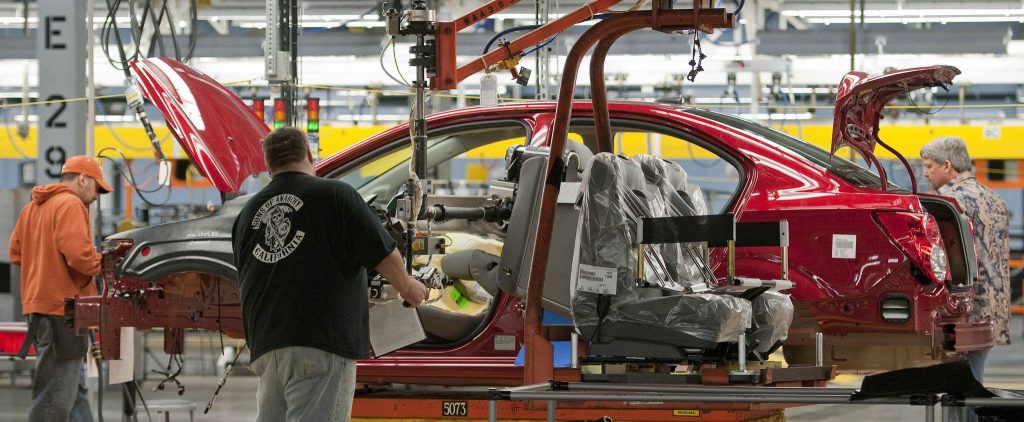The Trump administration is considering tariffs on automotive imports under the Section 232 provision for safeguarding U.S. national security.
Op-ed originally appeared on The Hill, June 19, 2018
Last month, Secretary of Commerce Wilbur Ross announced the investigation, with an invitation for written comments and public testimony. The administration will consider the comments that come in, with a final decision likely in the fall.
The steel and aluminum tariffs that came into effect earlier this month under Section 232 were based on the argument that civilian and military use of vital materials are inseparable. A healthy, progressive industrial sector developing military products and applications can only exist simultaneously with a healthy civilian industry.
Modern industry is large and complex. Developing new state-of-the-art products takes time and millions of dollars. The only way to build and sustain a world-class military industry is to share costs with a civilian industry.
That’s the business model that works for the steel and aluminum sector and the same logic also applies to the motor vehicle sector.
Historically, the civilian and military motor vehicle industry have always been intertwined. In World War II, General Motors, Ford and other carmakers were enlisted by the Roosevelt administration as a key pillar in making the U.S. the “arsenal of democracy.”
They overhauled their factories to build hundreds of thousands of military vehicles that powered the U.S. Army’s advances to victory in Europe and East Asia.
In 2003, General Motors (GM) exited the military contract business when it sold its GM Defense unit to General Dynamics for $1.1 billion. But GM has continued to supply powertrain components including engines, transmissions and parts to various military contractors.
Last year, GM re-entered the military contract business, establishing a new division, called GM Defense LLC. The new GM Defense currently has several major projects in development with the U.S. military.
The Silent Utility Rover Universal Superstructure or SURUS is a truck platform powered by hydrogen fuel cells. SURUS is based on a truck frame that was originally developed for commercial civilian markets.
Hydrogen fuel cells appeal to both civilian and military markets because they eliminate the need for petroleum-based fuels sources. The U.S. Army is evaluating the other advantages that a fuel-cell-based vehicle offers, including the silent operation of its electric motors and the ability to generate water from the hydrogen fuel source.
Another GM program that the Army is evaluating is the military version of the Chevrolet Colorado fuel cell-powered pickup truck known as Colorado ZH2. Meanwhile, the Navy is working with GM on underseas versions of these vehicles.
As with all motor vehicle product development, the costs of developing innovative new vehicle structures or power sources run into the hundreds of millions of dollars, so sharing of costs between multiple applications is essential for the economics to work.
Another example of military-civilian synergy is the new Joint Land Terrain Vehicle (JLTV), the Army’s replacement for the ubiquitous Humvee, which was widely used in Iraq and Afghanistan. After considering bids from a number of contractors, the Army awarded the contract to Oshkosh Corporation, a maker of trucks based in Wisconsin.
The JLTV is a fast, agile, heavily armored people-mover built to withstand land mines and other threats of modern wars. Each vehicle costs about $400,000. The Pentagon is asking for $1.1 billion to spend on JLTVs in the 2018 budget, with the first units expected to reach the field next year.
There is interest from the Air Force in the JLTV and numerous export opportunities. As in the GM case, the Oshkosh design of the JLTV benefits from Oshkosh’s civilian experience, know-how and development dollars.
Last year, Oshkosh earned $6.8 billion in revenue, most of it from heavy-duty trucks like cement trucks and refuse collection vehicles. Last year, Oshkosh’s defense division generated $1.8 billion or 26 percent of Oshkosh’s total revenue.
The presence of civilian-based motor vehicle companies to compete with traditional military contractors is important not only for product development but also to hold costs down.
As military contractors have tended to consolidate into fewer companies, civilian-based companies provide much needed competitive alternatives, helping the Pentagon realize better pricing and efficiency.
Equally important, the auto parts industry has consolidated into fewer players and much of it has moved offshore. A successful motor vehicles industry uses thousands of specialized parts. For national security, we need to be able to source significant volumes of all essential parts in the U.S.
In his notice on the auto investigation, Secretary Ross pointed out that imports of passenger vehicles in the U.S. have grown from 32 percent 20 years ago to 48 percent last year. At the same time, employment in motor vehicle manufacturing has fallen by 22 percent to around 950,000.
U.S.-owned vehicle manufacturers now account for just 20 percent of the global research and development spent in the sector. This decline raises the question of whether the industry has — or can sustain in the future — the resources for world-class design and development of next-generation vehicles.
The vehicle industry continues to be vital for the health of the civilian economy too. According to the Center for Automotive Research, every job in a body-on-frame pickup truck plant or related powertrain plant supports nearly 15 other jobs in the U.S. economy.













